Inflation Reduction Act: It’s a Big Deal for Job Growth and for a Clean Energy Future
On July 27, news whipsawed the nation’s capital as Senate Majority Leader Chuck Schumer and Senate Energy and Natural Resources Committee Chair Joe Manchin announced a compromise agreement and path forward on a comprehensive package of clean energy investments. Announced as the Inflation Reduction Act (IRA), this bill represents the single largest investment in renewable power in the history of this country, and the largest investment in climate action to date.
Most critically for the utility-scale clean power industry – and for the nation’s energy future – the bill extends the production tax credit and investment tax credit for wind and solar through 2024 before transitioning to a technology-neutral tax credit that will remain in place until 2032 or when electric-sector emissions fall to 75% of 2022 levels, whichever is later. Energy storage, for the first time, is made eligible to qualify for the investment tax credit, while domestic manufacturing of clean energy components is incentivized through component-specific production tax credits and an expansion of the 48(c) advanced manufacturing tax credit. Including these stable policies in the IRA that have been added to the final reconciliation legislation will finally unleash the full economic potential of swiftly deploying wind, solar, energy storage and transmission – and our industry is ready to deliver.
It’s hard to overstate the transformative impact that the IRA will have on the country’s electric grid – not to mention the broader climate benefits.
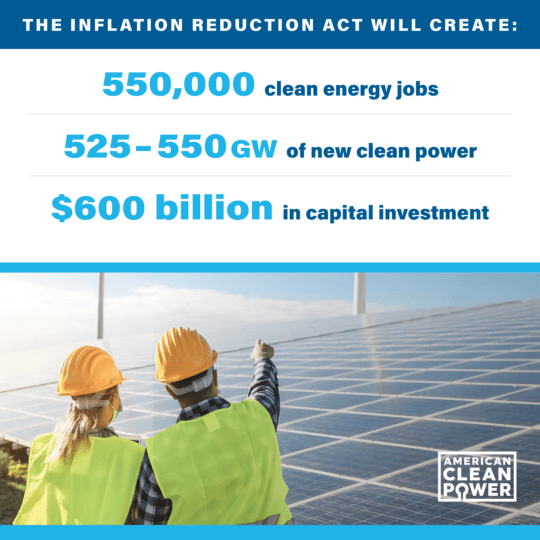
ACP’s preliminary assessment of the IRA is that its policies will deliver an estimated 525 to 550 gigawatts (GW) of new, utility-scale clean power from 2022-2030. As noted in our Q2 2022 Clean Power Quarterly Market Report, the current clean power operating capacity in the U.S. is now over 211 gigawatts – meaning that with the passage of the IRA, there will be roughly 750 GW of operating clean power capacity in 2030. With stable policies in place, we expect annual wind, solar, and energy storage capacity installations to grow to over 90 GW by the end of the decade, more than tripling the 28 GW installed in 2021.
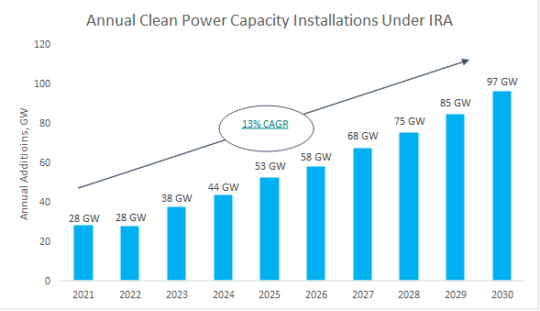
The pace of clean energy installations is expected to quicken over the course of the decade with the IRA’s provisions. By mid-decade, annual installations are expected to reach more than 50 GW before climbing further to over 90 GW by decade’s end. For comparison, the average industry forecasts under business-as-usual conditions anticipate 335 GW of new clean power additions, with the most prolific year clocking just under 50 GW installed. Passage of the IRA would shift American clean power growth into overdrive.
Let’s try to put those figures into more relatable terms. Adding 550 GW to the grid means that the newly added clean power plants will generate enough electricity to power the equivalent of 110 million homes across the country. That is nearly every home in America. Fold in the existing 211 GW of clean power and the fleet of wind, solar, and energy storage projects operating in 2030 will generate the same amount of electricity as consumed by the nine biggest electricity consuming states in the country.
More simply, it means that roughly 40% of the country’s electricity will come from wind, solar, and energy storage by 2030.
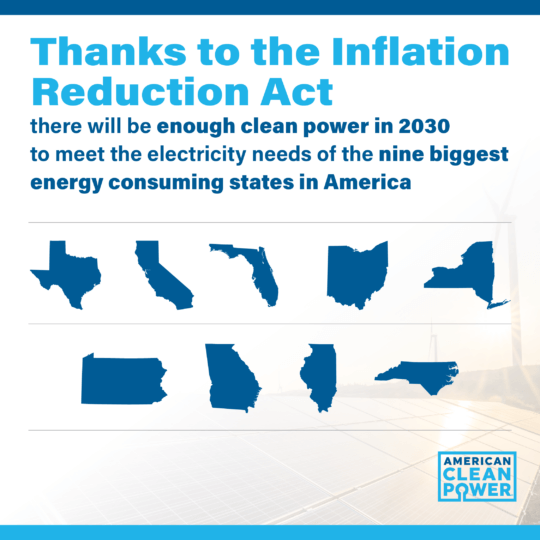
The growth of clean power will deliver a tremendous amount of new jobs and economic benefits across the country. ACP estimates that the IRA will help create 550,000 new clean energy jobs[1] – more than doubling the current clean energy workforce.
As a result, the clean power industry will support a direct workforce of nearly 1 million Americans by 2030.
These jobs will provide nearly $300 billion in wages and benefits to hard-working Americans. In addition, once complete, these projects will support 125,000 permanent jobs in the operations and maintenance phase, providing nearly $9 billion in wages and benefits each year.
Building 525-550 GW of new clean power capacity will generate $550 to $600 billion in capital investment. More broadly, construction of these projects is expected to generate over $900 billion in economic activity and add nearly $500 billion to U.S. GDP across the decade. After construction, ongoing maintenance and operations will contribute over $14 billion to U.S. GDP each year while generating nearly $29 billion in annual economic activity.
Critically, the bill is expected to fight inflation and lower consumers’ energy bills. Analysis from Rhodium Group finds that the average consumer can expect to save $1,025 in 2030 compared to today. Savings come from lower electricity costs, lower home heating costs thanks to a shift to electric heating, and lower mobility costs thanks to electric vehicles that will be increasingly powered by wind and solar.
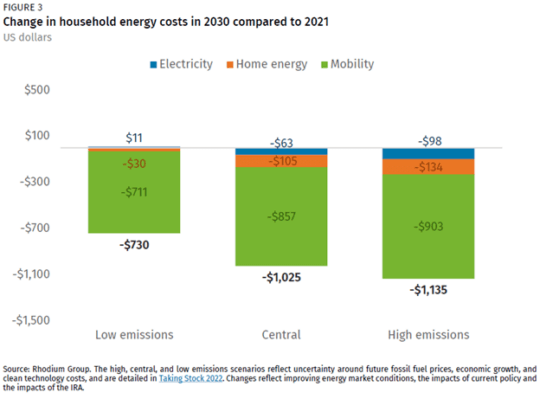
Importantly, the measures in the IRA package are expected to drive an estimated 40% reduction in economy-wide emissions by 2030, relative to 2005 levels. In the electric-sector alone, we expect clean energy resources to drive emissions to just one-third of 2005 electric-sector emissions levels by 2030. This keeps America within striking distance of the country’s 2030 emissions goal for the power sector.
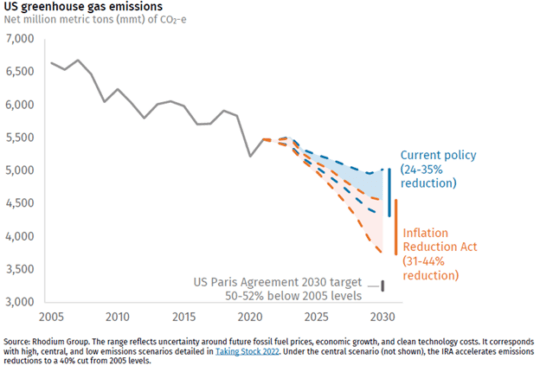
The IRA represents a monumental investment in the nation’s energy transition – an investment that will deliver clean energy, jobs, domestic manufacturing, economic growth and put the country in a much better position to deliver on our emissions goals. Swift action in Congress can help ensure these critical investments in our energy future move forward and the benefits reach all corners of America.
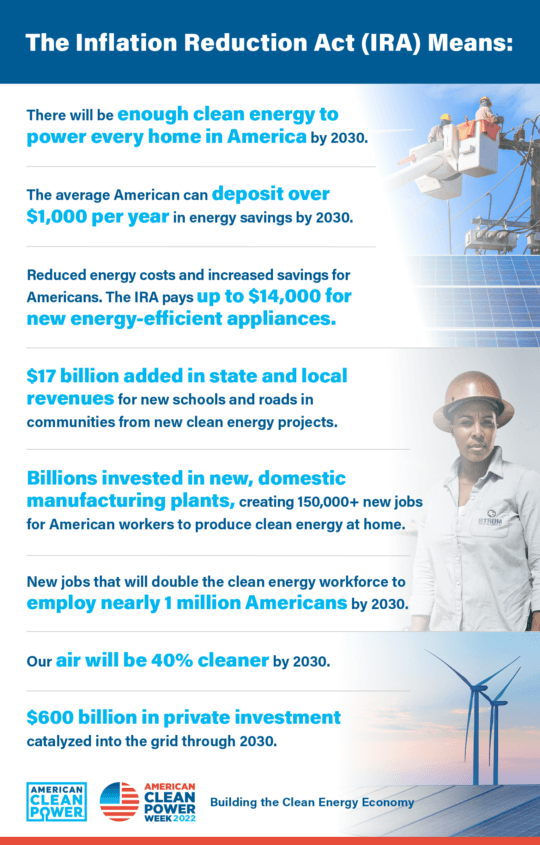
[1] Importantly, these figures don’t include induced jobs—those jobs supported in the community thanks to the investment in projects taking place.

